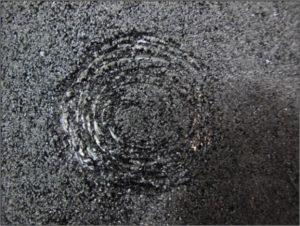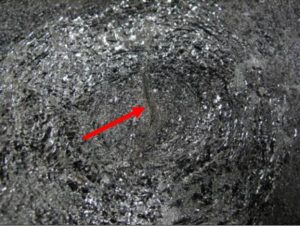For many types of roof evaluations, and especially when evaluating a roof for damage from hail impact, roof core sampling and laboratory testing are often helpful investigative tools. Such testing can help to provide for detailed evaluation of the roof membrane cross section for damage. Some of the most common tests performed by forensic laboratories on multi-ply bituminous membranes are delamination, wherein a sample’s individual plies are separated for observation with interply bitumen still present; and desaturation, wherein all bitumen is dissolved from a sample so the bare felt reinforcement mat can be directly evaluated.
Nelson has performed independent research on these test methods and has found that for evaluation of multi-ply bituminous membranes for hail impact distress, delamination testing can show distress to the interply bitumen at impact locations without distress being identifiable in the reinforcing mats upon desaturation.
Nelson’s research included impacting built-up roof (BUR) membrane samples with projectiles in a controlled setting, with a variety of projectile sizes/impact energies. Delamination testing performed on the samples revealed distinctive interply bitumen disturbances at impact locations (Figure 1). In general, these bitumen disturbances were similar to those resulting from hail impact, based on similar testing performed on samples for hail impact damage investigations.

Figure 1: Representative view of an impact disturbance at interply bitumen of a BUR sample.
Further desaturation testing of the same samples did not indicate felt ply disturbances that mimicked the location or extent of the aforementioned bitumen disturbances. For samples with ruptures in the felt plies, such ruptures were visible during the delamination testing, before the desaturation process had been performed. Therefore, for these samples, desaturation testing was not necessary to find that ruptures had occurred.
Nelson’s research and experience have shown that delamination evaluations of BUR membranes for hail impact damage are more visual and straight-forward in comparison with desaturation testing alone, and still allow for identification of felt ply ruptures caused by such impacts (Figure 2). Therefore, evaluation of the membrane bitumen via delamination testing is beneficial to a hail-damage investigation of such roof systems.

Figure 2: Interply bitumen disturbance with felt ply rupture evident.
Nelson’s team of professionals has decades of experience evaluating roof systems and other building elements and systems for damage related to hail impact. Nelson also has extensive experience in the laboratory analysis of roof samples. For additional information on the research discussed above, please click HERE to review the technical paper authored by Nelson professionals Justin Donaldson, P.E., Marco DeLeon, P.E., and Garrett Simpson, E.I.T., which was presented at the 2022 ASCE Congress on Forensic Engineering in Denver and was published with the conference proceedings.

